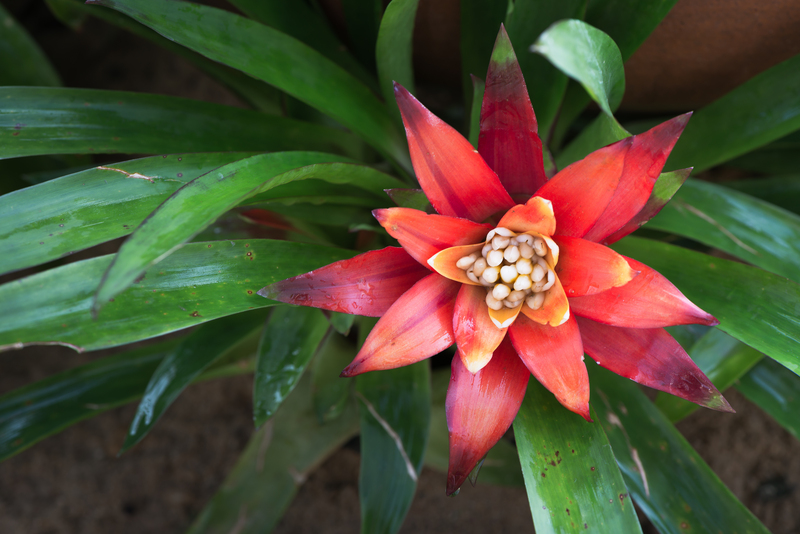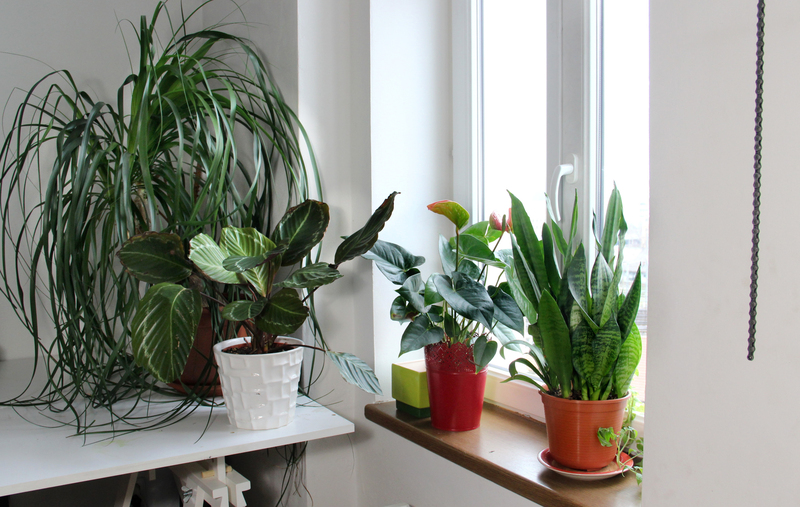A Green Landscape in Vertical Gardening
Posted on 18/09/2025
A Green Landscape in Vertical Gardening: Revolutionizing Urban Spaces
In today's rapidly urbanizing world, the concept of vertical gardening is transforming the way we think about green landscapes. Integrating vertical gardening solutions into cityscapes, homes, and commercial spaces is not just a trend--it has become a crucial strategy for sustainability, aesthetics, and wellbeing. If you're considering exploring a green landscape in vertical gardening, you're part of a movement that enhances the environment, boosts air quality, and creates striking visual impact.

What is Vertical Gardening?
Vertical gardening refers to the technique of growing plants on vertically suspended panels, walls, or structures, rather than on traditional horizontal garden beds. This innovative approach allows maximizing green space in areas where ground space is limited, making it an ideal solution for urban environments. The essence of vertical gardens lies in their ability to create lush, green landscapes by utilizing unused vertical surfaces.
The Benefits of a Green Landscape in Vertical Gardening
- Space Efficiency: Vertical gardens allow for the creation of dense green areas in tight spaces, such as patios, balconies, or building facades.
- Improved Air Quality: Green walls help filter pollutants and improve oxygen levels, contributing to healthier urban environments.
- Thermal Insulation: Growing plants vertically on building exteriors can moderate internal temperatures, reducing energy consumption.
- Aesthetic Appeal: Vertical gardens transform dull walls into vibrant, living works of art.
- Biodiversity Promotion: These gardens support a diverse range of plant species and pollinators within city spaces.
- Noise Reduction: Green landscapes in vertical structures can absorb urban noise, creating quieter and more peaceful environments.
- Wellbeing Boost: Enhanced greenery fosters psychological benefits, reducing stress and boosting mood.
Key Components of Vertical Gardening Systems
For anyone keen to cultivate a green landscape through vertical gardening, understanding its essential components is crucial:
- Structural Support: Strong frames, trellises, or panels to support the weight of soil and plants.
- Growth Medium: Lightweight soil substitutes or hydroponic setups, ideal for vertical dimensions.
- Irrigation and Drainage: Efficient watering systems are necessary to distribute moisture evenly without overwatering or leakage.
- Plant Selection: Choosing plant species suited for vertical growth, shading, and varying light conditions.
Types of Vertical Gardens for a Greener Landscape
1. Living Walls (Green Walls)
Living walls are perhaps the most iconic form of vertical gardening. These are self-contained vertical gardens that can be free-standing or attached directly to existing exterior or interior walls. They consist of a rigid frame, a waterproof backing, a growing medium, and an integrated irrigation system. Living walls are excellent for office buildings, schools, hotels, and homes, instantly adding a green landscape that captivates and inspires.
2. Green Facades
Green facades involve climbing plants that grow either directly on a building's facade or on specially installed support structures such as cables, mesh, or trellises. These facades provide shade, privacy, and energy efficiency, and act as striking architectural features that seamlessly blend nature with urban infrastructure.
3. Vertical Planters and Pocket Gardens
Vertical planters consist of bags, pockets, or modular containers that are mounted on walls, fences, or railings. These systems are highly versatile, making them perfect for home gardeners or renters who wish to experiment with vertical garden landscapes on a smaller scale. Herbs, succulents, ferns, and flowering plants thrive in such arrangements.
4. Hydroponic and Aquaponic Walls
Integrating hydroponics and aquaponics into vertical gardens presents an innovative and soil-free approach to green landscapes. Hydroponic walls use mineral nutrient solutions, while aquaponic systems combine fish farming with plant cultivation, promoting a closed-loop, sustainable method for food and ornamental plant production.
Essential Considerations When Planning a Vertical Green Garden
1. Sunlight and Plant Choice
Not all vertical installations are equal--sunlight exposure varies dramatically, and matching the right plant species to the light conditions is vital for lush growth. Use ferns, mosses, and shade-tolerant grasses for lower light areas, while succulents and flowering species suit sun-exposed walls.
2. Watering and Irrigation Systems
Efficient watering is a cornerstone of a healthy vertical landscape. Drip irrigation systems are highly recommended for their ability to deliver water directly to the root zone, minimizing waste. Automated timers ensure consistent hydration, particularly critical for larger installations or those in sunny climates.
3. Structural Integrity and Support
Vertical gardens can be heavy, especially when mature. It's crucial to assess wall strength and select suitable fixings. Lightweight materials, such as polyethylene panels, can reduce load, while regular maintenance avoids waterlogging and potential damage.
4. Maintenance Requirements
Like any living feature, vertical gardens need regular care. Pruning, replanting, fertilizing, and system checks will keep your green landscape thriving season after season. Look for self-watering and easy-access designs to simplify upkeep.
Design Tips: Creating a Living Masterpiece
- Mix Plant Textures: Combine trailing vines, spiky grasses, and clustering flowers for visual diversity.
- Play with Arrangements: Use vertical and diagonal planting schemes to create dynamic compositions.
- Seasonal Rotation: Refresh your vertical garden with seasonal blooms and greenery for year-round appeal.
- Incorporate Edible Plants: Grow herbs, strawberries, or lettuce to combine beauty with kitchen utility.
- Use Native Species: Native plants adapt better to local climates, reducing maintenance and maximizing biodiversity.
Innovations and Future Trends in Vertical Gardening
As cities expand, the demand for vertical green landscapes only grows. Increasingly, architects, urban planners, and homeowners are embracing technology-driven solutions for vertical gardening:
- Smart Irrigation: Sensors and automation for optimal water use and scheduling.
- Eco-Friendly Materials: Recycled plastics, biodegradable panels, and sustainable substrates for greener construction.
- Integration With Renewable Energy: Solar panels and wind turbines paired with green walls.
- Urban Farming: High-yield hydroponic towers for fresh produce in supermarkets, schools, and community centers.
The intersection of digital innovation and green design is set to push the boundaries of vertical landscape gardening for years to come.
Case Studies: Inspirational Vertical Landscapes Around the World
1. The Bosco Verticale, Milan
One of the most renowned examples of living vertical architecture is Milan's Bosco Verticale (Vertical Forest). These residential towers host over 900 trees and thousands of shrubs, transforming the city skyline into a living, breathing ecosystem. The project has inspired city planners worldwide to reconsider what a green landscape in vertical gardening can achieve.
2. The CaixaForum Green Wall, Madrid
In Madrid, the stunning vertical garden at CaixaForum designed by Patrick Blanc boasts over 15,000 plants from 250 species, flourishing on a six-story wall. This urban masterpiece demonstrates how vertical gardens can act as focal points in city culture.
3. Singapore's Supertree Grove
The legendary Supertree Grove in Singapore's Gardens by the Bay has redefined vertical gardening. These iconic structures not only feature a green landscape in vertical gardening but are equipped with solar panels, rainwater collectors, and skywalks, blending sustainability and tourism.
DIY: How to Start Your Own Vertical Green Garden
While large installations may require professional input, creating a green vertical landscape at home is achievable for most. Here's a step-by-step guide:
- 1. Choose Your Space: Find an accessible wall, fence, or balcony with the right light conditions.
- 2. Select the Structure: Use a premade pocket panel, a recycled wooden pallet, or build a modular grid with planters.
- 3. Pick Appropriate Plants: Herbs, succulents, trailing vines, ferns, and small flowers are all excellent choices for beginners.
- 4. Add the Growing Medium: Fill pockets or containers with high-quality, light soil or a hydroponic substrate.
- 5. Install Drip Irrigation: Even a basic drip kit ensures uniform watering and minimizes effort.
- 6. Regular Maintenance: Check for pests, fertilize monthly, and prune overgrown plants for best results.

Common Challenges and Solutions in Vertical Landscape Gardening
- Water Leakage: Ensure waterproof backings and proper drainage layers to protect walls.
- Plant Failure: Select species suited to the specific microclimate and soil conditions of your wall.
- Overweight Systems: Use lightweight substrates and consult a structural engineer for large installations.
- Pest and Disease Management: Regular inspection and natural pest control methods help maintain plant health.
The Future is Vertical: Reimagining Green Landscapes
The growing popularity of vertical gardening signifies a larger shift towards sustainable living and urban resilience. As green landscapes stretch skywards, they offer efficient, low-impact solutions for food production, biodiversity, and climate mitigation. Embracing a green landscape in vertical gardening not only beautifies concrete jungles--it actively shapes healthier, happier, and more environmentally conscious cities.
Are you ready to transform your living space with a vertical garden? Whether you're an urban dweller, office manager, or simply a lover of lush scenery, the possibilities are endless. Make your mark in the green revolution--let your landscape grow upward and thrive!

